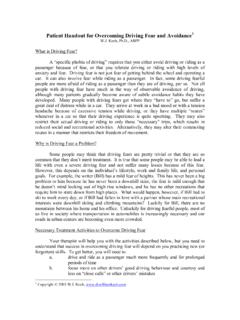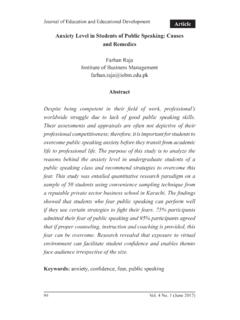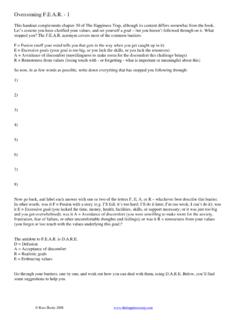Transcription of Nature and the Outdoor Learning Environment: The Forgotten ...
1 International Journal of Early Childhood Environmental Education, 3(1), p. 85 International Journal of Early Childhood Environmental Education, 3(1) Copyright North American Association for Environmental Education ISSN: 2331-0464 (online) Nature and the Outdoor Learning Environment: The Forgotten Resource in Early Childhood Education Allen Cooper National Wildlife Federation The whole playground is so much more engaging; the kids are neither overwhelmed nor bored. They didn t run they run. Our proudest moment has to be watching the children with the natural elements: flowers, branches, overcoming fear of bees, worms, butterflies, and crickets. (Childcare professional at Munchkin Academy, Buxton, NC, describing the impact of enhancements to the center s Outdoor setting.)
2 Longitudinal studies now confirm the economic, academic, and social importance of high-quality early childhood education. At the same time, a substantial body of research indicates that an Outdoor Learning and play environment with diverse natural elements advances and enriches all of the domains relevant to the development, health, and wellbeing of young children. Despite these findings, the Outdoor Learning environment goes virtually unmentioned in national and state level standards, guidelines, and regulations, and has been largely overlooked in the considerable efforts to enhance the quality of early childhood education (ECE). Moreover, children most likely to benefit from an Outdoor play and Learning environment are less likely to have access to one.
3 A natural Outdoor play and Learning environment is Outdoor space at an early childhood education center that includes diverse features designed to promote structured and unstructured physical activity, play, and Learning . The two photos below, provided by the Natural Learning Initiative at North Carolina State University, show the Munchkin Academy in Buxton, North Carolina before and after addition of trees and shrubs, raised garden beds, and a looping pathway: International Journal of Early Childhood Environmental Education, 3(1), p. 86 This article lays out recommendations for increasing the availability and use of natural Outdoor play and Learning environments in order to improve the quality of ECE.
4 The article begins with a summary of research indicating the contribution of an Outdoor Learning environment to the domains of ECE; describes the current policy related to the Outdoor Learning environment and Nature exploration in state regulations; identifies model policy content in key areas; and concludes with specific actions that will increase availability of quality Outdoor Learning environments. Benefits of Natural Outdoor Play and Learning Environments Improves self-regulation Advances physical fitness and gross motor development Improves nutrition Improves eyesight Promotes cognitive development Improves academic performance Lessens the symptoms of ADHD and improves concentration Promotes self-confidence Builds understanding and appreciation of ecosystems, food systems, and environmental processes Proposed Minimum Standards to Promote Quality Natural Outdoor Learning Environments Formally designate the Outdoor space an Outdoor play and Learning environment or similar The Outdoor play and Learning environment has at least two Outdoor gross motor features (.)
5 Climbing features or looping pathways) The Outdoor play and Learning environment has at least two Outdoor Learning settings ( , gardening area, loose parts station, or dramatic play area) The Outdoor play and Learning environment includes a diverse selection of plants and habitats representative of local flora and fauna The Outdoor play and Learning environment includes natural features that enrich children s play and Learning such as: non-toxic trees, shrubs, or vines; topographic variations (such as mounds, terraces, slopes); a variety of ground surfaces (mulch, grass, pebbles); smooth rocks, wood or logs; non-poisonous flowering plants or garden plants and vegetables; birdfeeders, bird baths and birdhouses An Outdoor water source for irrigation is available The Outdoor play and Learning environment has a looping pathway and wheeled toys At least 30 minutes of Outdoor time is offered per three hours at the center.
6 Consumption of fruits and vegetables grown on site is expressly allowed A Nature supplement for early Learning guidelines is adopted Professional development for enhancing and utilizing the Outdoor play and Learning environment is provided Each center has Outdoor space of at least 75 sq. ft. per child, with exemptions granted only if daily walking outings to nearby parks or public spaces are provided International Journal of Early Childhood Environmental Education, 3(1), p. 87 Strong evidence that Nature inquiry and Outdoor Learning environments advance the goals of ECE ECE programs are expected to foster the physical, mental, and social-emotional development of children, and, increasingly, to address an array of threats to American children s health and wellness.
7 The prevalence of overweight children ages 6 to 11 has more than doubled in the last 20 years, increasing to in 2004, and the rate among adolescents has more than tripled (CDC 2007). Overweight and obese children suffer from a myriad of health problems, including higher risks of cardiovascular disease, diabetes, bone and joint problems, and sleep apnea (Ogden 2006). These health problems are so severe that researchers warn of the possibility that for the first time in American history, life expectancy may actually decrease because of the health impacts of the current childhood obesity epidemic (Olshansky et al 2005). In the area of mental health, approximately 11% of children have been diagnosed with Attention Deficit/Hyperactivity Disorder (ADHD) with the rates of diagnosis increasing 5% per year from 2006 to 2011 (CDC 2014).
8 School readiness is seen as a growing responsibility in ECE, and the K-12 standards movement has had a substantial impact on ECE, with virtually every state and territory adopting Early Learning Guidelines which specify desired ECE Learning and development outcomes, often aligned with K-12 standards. If ECE is to contribute to addressing these challenges then all available resources must be mobilized. A growing body of scientific literature indicates that play and Learning in a diverse, natural area provides a wide array of health, Learning , gross motor, and mental health benefits for children. Learning and Cognitive Development Promotes Cognitive Development. The richness and novelty of being outdoors stimulates brain development (Rivkin 2000).
9 Research shows that direct, ongoing experience of Nature in relatively familiar settings remains a vital source for children s physical, emotional, and intellectual development (Kellert 2004). Proximity to, views of, and daily exposure to natural settings increases children s ability to focus and enhances cognitive abilities (Wells, 2000). Improves academic performance. Studies in the US show that schools that use Outdoor classrooms and other forms of Nature -based experiential education show significant student gains in social studies, science, language arts, and math. Students in Outdoor science programs improved their science testing scores by 27% (American Institutes for Research, 2005). Mental Health, Self-Regulation and Improved Behavior Promotes constructive, imaginative, and collaborative play.
10 Lower quality Outdoor environments are associated with repetitive play and negative behavior, while higher quality environments are associated with more constructive play (DeBord, Hestenes, Moore, Cosco, and McGinnis 2005). Natural materials added to the Outdoor environment increase children s spatial-cognitive awareness, physical competence and skills, and socialization (Herrington and Studtmann 1998). Inclusion of loose parts of natural materials increases constructive and dramatic play (Hannon and Brown 2008.) Improves Self-Regulation and Reduces Stress and Aggression. Time spent in green spaces, including parks, play areas, and gardens, has been shown to reduce stress and mental fatigue (Taylor 2001). In one study children who were exposed to greener environments in a public housing area demonstrated less aggression and violence and less mental stress (Kuo & Sullivan 2001).



















